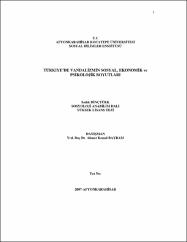Türkiye’de Vandalizmin Sosyal;Ekonomik ve Psikolojik Boyutları
Citation
Sadık Dinçtürk '' Türkiye’de Vandalizmin Sosyal;Ekonomik Ve Psikolojik Boyutları ‘’ Socıal, Economıcal And Phychologıcal Aspects Of Vandalısm İn Turkey’’ Afyon Kocatepe Üniversitesi Afyonkarahisar 2007Abstract
Vandalizm psikolojik, sosyolojik ve ekonomik sonuçları olan ciddi bir problemdir.
Vandalizm, 4. ve 5. yüzyıllarda Batı Avrupa’yı istila eden, geçtikleri her yeri yakıp yıkan ve
M.S. 455 yılında Roma’yı yagmalayan bir dogu Alman boyu olan Vandallar’a atfen, bir
kimsenin kamu mallarına ya da tanımadıgı kisilerin mallarına yönelik saldırganca
davranıslarda bulunma egilimini ifade etmek için kullanılan bir terimdir. Bu olguya ilk kez,
Fransız yazar Abbé Grégoire 1794 yılında Paris'te yapılan bir toplantıda dikkat çekmis,
1789 Fransız Devrimini izleyen yıllarda vatandasların tarihi eserleri tahrip etmelerini
önlemek gerektigini vurgularken "vandalisme" terimini kullanmıstır.
Sahiplenmenin olmayısı, nüfus yogunlugu, egitim eksikligi ve yogun kullanım gibi
etmenler vandalizmin nedenleri arasında sayılabilir. Vandalizm türlerini açgözlü, ideolojik,
kinci, oyunsu ve kötü niyetli vandalizm olarak sıralayabiliriz. Vandalizm siddet,
saldırganlık, kisilik bozuklugu ve birtakım sosyolojik faktörlerle baglantılı bir eylemdir.
Vandalizmin kamu mallarının tahribi, kazalara neden olusturma, baska suçlara neden
olusturma, görsel kirlilik ve maliyet gibi kentsel yasama birtakım etkileri vardır. Vandalizmin
en çok görüldügü alanlar, okullar, ulasım ve haberlesme araçları, spor alanları, park ve
bahçeler, resmi ve özel konutlar, kütüphaneler, tarihi eserler ve sanatsal yapılardır.
Vandalizmin tüm dünyada oldugu gibi ülkemiz açısından da yıllık ekonomik maliyeti
milyon dolarlarla ifade edilecek kadar büyük boyutlara ulasmıstır. Bu çalısmadaki temel amaç
vandalizm eylemine ve bu eylemin önemine dikkat çekmek, vandalizmin yol açtıgı zararların
boyutlarını ortaya koyabilmektir. Bu konuda, toplumda sorumlu olan herkesin ve her
kurumun gereken hassasiyeti göstermesi gerekir. Çünkü artık vandalizm, görmezden
gelinecek basit bir eylem degildir. Vandalism is a serious issue with psycological, social and economical consequences.
Vandalism is a term that is derived from the Eastern Germanic tribe, the Vandallar’s who
ravaged Western Europe in the Fourth and the Fifth Centuries burning and trashing where
they went as well as raiding Rome in the year 455; it defines the assault intended act of
individual or group to public property, or the property of unknown people. In 1794, the
French writer Abbe Gregoire was the first person to draw attention to this phenomena at a
meeting in Paris, using the word “vandalisme” when raising voice for the prevention of the
destruction of historical works of art by the public during the French Revolution preceeding
1789.
Some of the reasons for vandalism can be the ignorance of propertyhood, population
density, insufficient education and exhaustive use. The acts of vandalism can be described
as cunnary, ideologic, expression of hate, malicious and ill-intent. It is an act related to
violence, assault, personality problems and other social factors. Vandalism can effect city
lifestyles in the attrition of public property, causing accidents, leading to other offences,
creating visual pollution and costs. Vandalism is most common at regions of schools, means
of transportation and communication, sporting facilities, parks and gardens, official and
private buildings, libraries, historical works of art and architectures.
The costs of vandalism, for the nation, as in the rest of the world has reached concerning
level of millions of dolars per year. The fundamental objective in this study is to draw
attention to vandalism and the importance of this act, highlighting the true frame of resulting
losses. The community and every responsible figure and institutions needs to show the
necessary sensitivity on this issue. Vandalism is no longer a tolerable simple act.
Collections
- Yüksek Lisans Tezleri [2029]



















